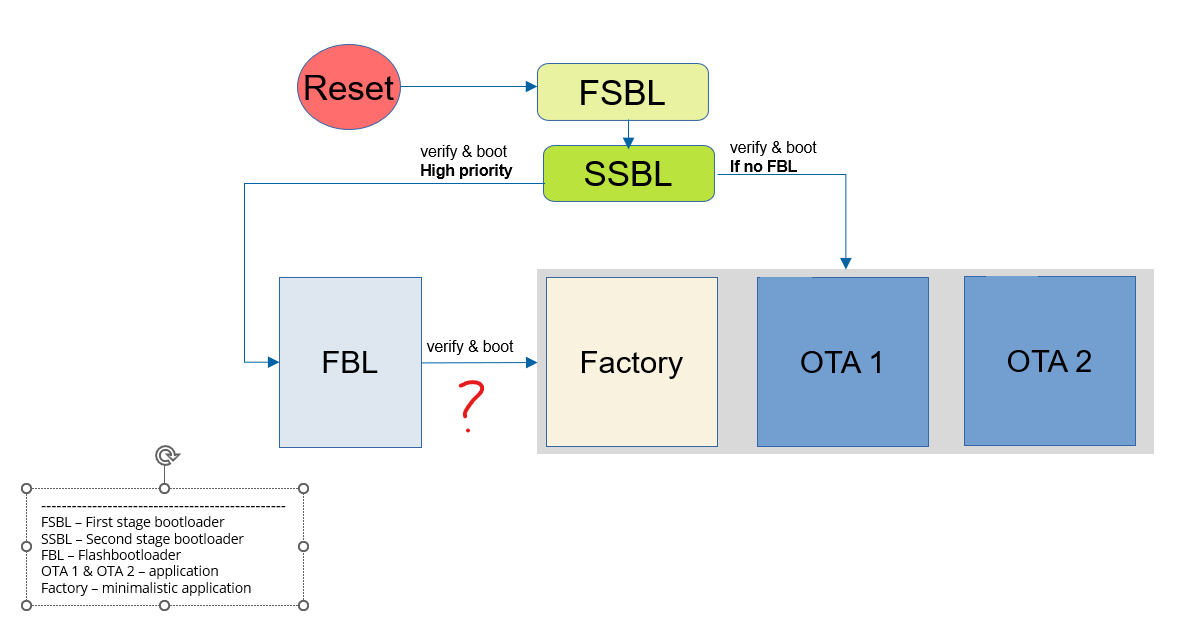New issue
Have a question about this project? Sign up for a free GitHub account to open an issue and contact its maintainers and the community.
By clicking “Sign up for GitHub”, you agree to our terms of service and privacy statement. We’ll occasionally send you account related emails.
Already on GitHub? Sign in to your account
2-Stage Application Concept (IDFGH-8718) #10159
Comments
|
I think something similar has been implemented in a number of projects already, as follows:
This enables the following workflows:
For example, in one such project, the "factory" app would also present a menu on an LCD screen, letting the user to select the app ("game") to boot. The "factory" app also set up a webserver over Wi-Fi, letting users to update other apps ("games"). In your example, the "factory" app can get the update over CAN bus. |
|
Von: Ivan Grokhotkov ***@***.***>
Gesendet: Freitag, 11. November 2022 11:35
An: espressif/esp-idf ***@***.***>
Cc: Franz Höpfinger ***@***.***>; Author ***@***.***>
Betreff: Re: [espressif/esp-idf] 2-Stage Application Concept (IDFGH-8718) (Issue #10159)
I think something similar has been implemented in a number of projects already, as follows:
* "Factory" partition is used as the "3rd stage" bootloader, which can download applications from various sources (Wi-Fi, SD card, etc)
* "OTA" partitions are used to store the actual applications
This enables the following workflows:
* Normal boot: 2nd stage bootloader loads the app from one of the OTA slots, the app starts running.
* Upgrade:
* OTA app receives an event that triggers the upgrade.
[FH] @***@***.******@***.***> this would mean: we integrate the Detection of the „Magic Packet“ into the Main App. So the Update can be started anytime, no need to flood the Bus with the Magic Packet. The Box can Boot, run 1 hour, then the Magic Packet is received by the normal App, and the following happens
* It calls esp_ota_set_boot_partition(factory_partition) and restarts.
[FH] this is done inside the app.
* The 2nd stage bootloader loads the factory app because it is now set as the boot partition.
* The factory app downloads the update from one of the interfaces and flashes it into an OTA slot.
* The factory app calls esp_ota_set_boot_partition(ota_partition) and restarts.
[FH] this could even be happening in case of Error, Timeout, no Binary received etc..
* The 2nd stage bootloader loads the app from the selected OTA partition.
* Fallback:
* If an OTA app fails to boot after the upgrade, the 2nd stage bootloader can switch the default boot app to "factory", enabling recovery process. This can be done using CONFIG_BOOTLOADER_APP_ROLLBACK_ENABLE option.
For example, in one such project, the "factory" app would also present a menu on an LCD screen, letting the user to select the app ("game") to boot. The "factory" app also set up a webserver over Wi-Fi, letting users to update other apps ("games"). In your example, the "factory" app can get the update over CAN bus.
[FH] yes, really cool concept.
If both apps OTA1 and OTA2 are damaged: the Factory App allows reprogramming.
If the App is running, but the Part where the magic packet is received and the switch to the factory app is done is damaged, then we have a Problem. This can be avoided by good Testing,
and maybe inventing a 2nd way of getting into Factory, e.g. over Wifi or MQTT.
Cool concept!!
—
Reply to this email directly, view it on GitHub<#10159 (comment)>, or unsubscribe<https://github.com/notifications/unsubscribe-auth/AQSZUH4ZVVX4ZNJFL4Q6BNLWHYOO3ANCNFSM6AAAAAAR5M5CLI>.
You are receiving this because you authored the thread.Message ID: ***@***.******@***.***>>
[https://www.meisterschulen-mchn.de/images/meisterschulen/allgemein/4-logos/logofc.jpg]
Meisterschulen am Ostbahnhof
Mühldorfstr. 6
81671 München
Tel.: 089 416002 - 0
Fax: 089 416002 - 111
Internet: www.meisterschulen-münchen.de<http://www.meisterschulen-mchn.de>
|
|
Yes, we have thought about putting the FBL as Factory, but it will not be possible to update the FBL after that. |
There's actually no restriction on writing to 'factory' partition. I think this scheme can be extended to make the factory partition updatable. You can add another partition (ota2) which would contain the dedicated 'factory partition updater app'. If the main app gets an event that signals the factory partition update, it sets the boot app to ota2 and resets. The rest of the logic is similar. You may use a customized 2nd stage bootloader to implement custom boot priorities, if necessary — please refer to custom bootloader examples for that. |
|
@igrr is this CONFIG_SPI_FLASH_DANGEROUS_WRITE_ALLOWED neccessary ? du to my understanding it is protecting Partition Table and Bootloader, not the Factory App right ? |
|
CONFIG_SPI_FLASH_DANGEROUS_WRITE_ALLOWED is only necessary to overwrite:
So if you aren't trying to overwrite |
|
@franz-ms-muc it seems that the question has been answered, can we close the issue now? |
|
Close |
|
@igrr can you give a Hint to https://www.esp32.com/viewtopic.php?f=13&t=31895&sid=7e8498b82177cfeb323f1ff006b10162 Thanks ! |
|
Have replied. |
|
Outstanding good Support ! |


Is your feature request related to a problem?
not Really.
Describe the solution you'd like.
We want to extend the Application Bootup.
now it is like https://docs.espressif.com/projects/esp-idf/en/latest/esp32/api-guides/startup.html.
Our goal is to have another way to Flash the OTA0 and OTA1 Partitions, over a so-Called FBL (Flash Bootloader) which is able to get a new Application Binary over CAN-BUS (J1939, UDS).
Therefore our intended Startup Flow would be:
i think @igrr is a guy who can answer this.
Describe alternatives you've considered.
Alternative considered is to boot FBL, and then make a Reset,
so the Second stage bootloader sees "we are in a warmstart" and start OTA1 or OTA2. But then we must extend the Bootloader, and it must know that FBL has already run, so decide if it is a warmstart or a coldstart.
Additional context.
No response
The text was updated successfully, but these errors were encountered: